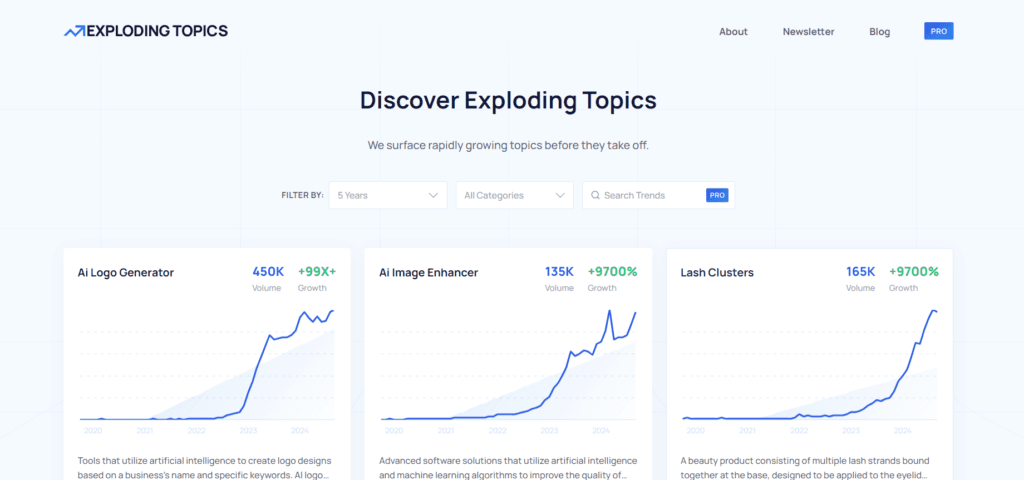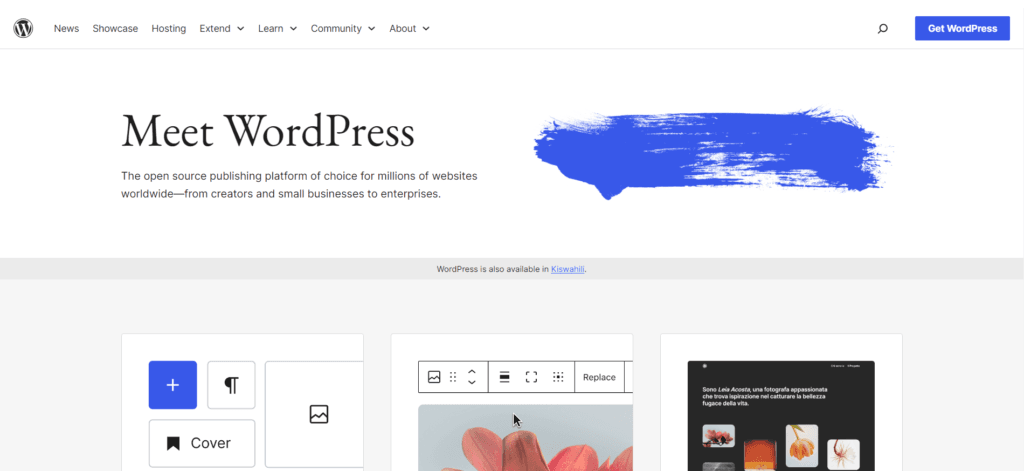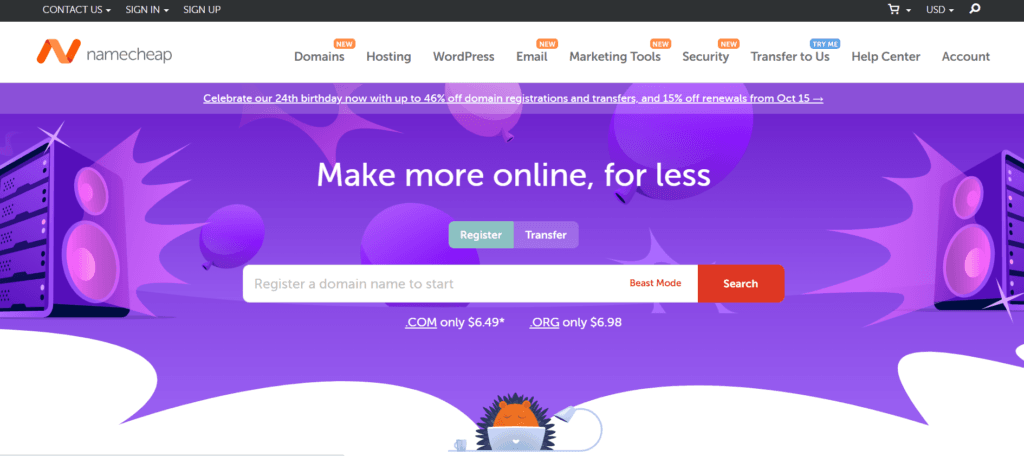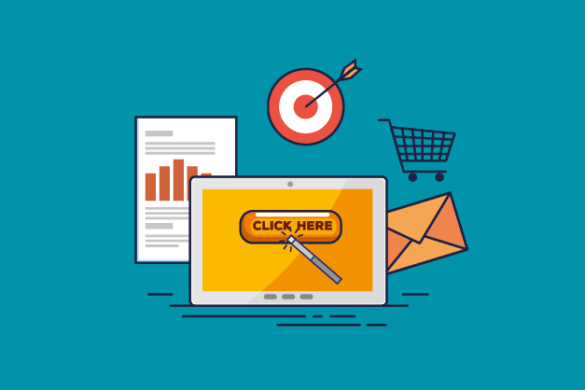Table of Contents
Learn how to start a blog from scratch like a pro with this simple 5+ step beginner’s guide. In a few minutes, you will learn how to start blogging for beginners, launch and grow your blog, and start a blogging business. From choosing a domain name to earning six or seven figures.
There’s a lot to cover, so sit back, and relax. If you’re curious about how to start a blog and make money, you’re in the right place. Learn along the way, or open a separate tab on your browser to start building your blog now.
Let’s get into the good stuff and learn how to start your own blog.
What is a Blog?
A blog is like your personal online magazine. If you’ve ever pondered over how to start a blog, it’s essential to understand its nature. It’s a space where you regularly publish content on topics you’re passionate about. These can range from personal experiences and hobbies to in-depth guides and professional advice. Unlike traditional media, a blog is often run by individuals or small teams, making it a more personal and direct way to communicate with readers. With the rise of the internet, blogs have become an essential tool for sharing information, teaching new skills, and building communities around shared interests.
If you’ve wondered how to start blogging to voice your thoughts, share your expertise, or simply connect with others, then starting a blog is the way to go. Dive into this guide to understand how to start blogging.
How to Start a Blog?
A blog is a fantastic way to share your ideas, interests, and knowledge with the world. However, where do you even start? How can a blog be started? The process of starting a blog may seem overwhelming to individuals who are considering this for the first time. There are several things to consider, such as deciding on a name, where to host it, and how to write your first post. But don’t be concerned! It may appear difficult at first, but it becomes much easier with a detailed, step-by-step tutorial. If you’ve ever said to yourself, “I’d love to start a blog, but I don’t know how,” you’re in the right place. You can start blogging by following our 8-step guide, which will walk you through every step. Now let’s get going!
Step 1: Pick the Right Niche to Start a Blog
So, this is the first step in my guide on how to start blogging for beginners. Picking a niche is like picking a specific interest. Your blog topics will revolve around that area, targeting a specific audience. And to answer how to start a blog starts, should begin with a niche.
You can pick any niche, but you must choose something you’re passionate about so your blogging journey can keep you excited.
Here are some tips for brainstorming niche ideas:
1. Blog Your Interest
If you’re starting a blog, pick a topic you’re passionate about, like cooking, fashion, or travel. Broad topics are competitive, so you need to narrow down your focus to stand out.
For example, if you love cooking, try focusing on ‘easy vegan recipes for busy professionals’ or ‘quick meals for college students.’ This helps attract a specific audience, making your blog more engaging and easier to grow.
2. Get Inspired by Competitors
To start a blog, first, choose something you like and know about. Check out other blogs in that area to see what they write about. Look for anything they might be missing or not talking about much.
You can consider starting a blog from here. Or, see if they’re paying very little attention to specific topics, but there’s a lot of content that needs to be written around those keywords. Start from there.
3. Blog Hottest New Trends
Visit websites like ExplodingTopics, Google Trends, and Feedly to discover the hottest new trends in all industries before starting a blog. Start your blog around those trending topics to gain attention faster.

4. Blog Unheard Stuff
Discover new unheard product and information categories by visiting these websites: Amazon, WikiHow, PayPal, and Udemy. Usually, there are very few good enough blogs that cover those new unheard categories. That’s an edge to quickly dominate that space.
5. Blog Your Job or Skill
Write about your past or present jobs or skills. Because, if you are wondering how do I start a blog, you need to learn to demonstrate yourself to the public. Write interesting stories, and facts, or publish valuable content that can help newcomers.
6. Blog Your Favorite TV Show
What is your favorite television show? When deciding how to start a blog, consider blogging about its cast. What they wear, who they are, their net worth, other shows they’ve created, real-life activities, fascinating stories, and a lot more.
What’s interesting is that you can always change the blog’s categories as the cast creates new movies, shows, interviews, or says funny things on social media. Begin with your favorite show and gradually expand that blog into a massive celebrity gossip blog.
Step 2: Choose the Right Blogging Platform
The first and most important step in figuring out how to start a blog is deciding on a publishing platform. A blogging platform is a software-driven service that allows you to publish blog posts. Just like creating a Facebook account to publish posts. If you’re learning how to start a blog, selecting the right platform is an important step.
There are two types of blogging platforms you should consider when asking yourself the question how do I start a blog:
1. Self-Hosted Blogging Platforms
Simply put, it’s paid blogging. You pay for the domain and hosting.
You’ll have a unique website URL and complete control over your site, including the ability to install third-party themes, plugins, and other features. Monetization is easier with self-hosted blogging, and there are more opportunities to make money.
Self-hosting blogging is always the best option if you want to pursue a blogging career. (More about the costs below.)
The absolute best and the most popular self-hosted blogging platform is ‘WordPress.org’, stats show.

It’s open-source, free software that lets you create and customize your website however you want. You are not bound by any “terms and conditions” and will not be required to satisfy or convince anyone.
You are free to do your own thing. You can create, publish, sell, give, take, or do anything. That is what makes WordPress.org great. (Do not confuse it with WordPress.com, which is a separate platform with limitations). In Step 4, I’ll show you how to set up and design your WordPress blog.
Some alternatives of WordPress: Hubspot CMS drag and drop website builder, Wix drag and drop website builder, and Gator website builder with pre-made templates.
Webflow has also emerged as a serious competitor to WordPress. It’s a no code web design platform with its own hosting and CMS. Here’s a side-by-side comparison of Webflow and WordPress.
2. Hosted Blogging Platforms
There may be tricky parts to figuring out how to start a blog. Although hosted blogging is free, it is not ideal due to limitations that impede your blogging growth. Such as;
The strict rules of the platforms you’ll be blogging on
There are significantly fewer options for customizing your website. Additionally, your website’s URL will appear unprofessional. (Yourname.platform.com)
In short, you won’t truly own anything until you pay for and upgrade to self-hosting.
If you’re into blogging to make a living, I will not recommend free platforms. But, if you’re just a hobbyist, these can be good: Blogger, Medium, LinkedIn, or Tumblr. So, if you were wondering how to start a blog, you should think about hosted blogging platforms.
3. Costs of Starting a Self-Hosted Blog
It varies. Several factors come into play. Let me explain.
You’ll need to purchase a domain name, hosting service, sometimes premium themes, and maybe even some premium plugins. Not to mention the hardware costs; laptop, Wi-Fi router, headphones, etc.
If you have poor Wi-Fi and a slow laptop, please count an upgrade or fix for those separately. Here’s what you can expect:
As a full-time blogger on WordPress, with web-hosting and domain from Bluehost, and Domain Privacy and Protection, your initial cost can sum up as 77$ per year with the Basic plan. Since the domain is free for one year on Bluehost, you’re saving around 18 bucks in your first year.
(This digit can vary if your domain and service provider is other than Bluehost)
Step 3: Get Domain Name and Web Hosting
How do you start a blog with the right domain and web hosting? There are two main steps in this section. We’ll go through them separately to avoid confusion.
1. Choose Your Blog’s Domain Name
When you’re figuring out how to start a blog, one of the primary considerations is your domain name. A domain name is your unique internet address. Users will type that in the search bar to find your website. But it also serves a deeper purpose: an iconic name can have a positive impact on the overall image of your blog.
A good example is Scary Mommy, a name that is both descriptive and funny, it’s a humorous take on the challenges of motherhood. All within a name that’s impossible to forget.
Here are a few guidelines to make it memorable:
- Keep it simple, short, catchy, and memorable. Less than 15 characters are usually ideal. (Exceptions for out of the box creative ones)
- Read relevant books, watch movies, use a dictionary and thesaurus, or combine words with your name for ideas. It usually works all the time.
- It’s ideal for keeping it relevant to what your blog is about. For instance, if you’re an outdoor lifestyle blogger, maybe you could go with something like ‘Outdoorsy.com’.
- Use a blog name generator like Nameboy. The names generated with the AI tool might not be the best, but they may get you something desirable to brainstorm epic ideas.
- Use our name ideas for travel, lifestyle or fashion blog.
But, where can you get your domain name? There are domain name service providers like Namecheap, Hostgator, or GoDaddy, and Bluehost.

And no harm if it’s not a ‘perfect’ name – you can always change later. The real deal is to start. Once you decide on your domain name, pay attention to the next step. How do you start a blog? With the right domain.
2. Get Web Hosting for Your Blog
How do you start a blog if you are missing a hosting? Web hosting is like purchasing separate storage for your website. When exploring how to start a blog, understanding web hosting is fundamental. The hosting service provider will make sure the content of your blog is online there and is accessible for everyone on the Internet 24/7.
There’s more to web hosting, but we don’t need to get technical here.
So, how do you start a blog and where do you get web hosting? Bluehost, Hostgator, Dreamhost, SiteGround, NameHero, and Hostinger – these are one of the popular ones to date. All of these are affordable with different prices and plans, and other features. lso EuroDNS, a popular hosting provider offers shared hosting plans starting at $1.99/month, perfect for bloggers on a budget. You can get your hosting and domain from any of these you like, all of these are reliable.
I usually recommend Bluehost because:
- Easy to use, fully beginner-friendly.
- Automatic integration of WordPress.
- Affordable for beginners, great value for the money.
- Drag and drop website builder
- 2 million websites hosted by Bluehost currently, suggesting that it’s reliable.
- Credible, even WordPress.org recommends it.
- Free domain name for 1 year.
Step #4: Set Up Your Blog on WordPress
So, if you are figuring out how to start a successful blog, you should get familiar with WordPress. If you’re using Bluehost, Dreamhost, or SiteGround as hosting service providers, you don’t need to do anything. Your website will be automatically integrated with WordPress. If it’s otherwise, you need to manually download and install WordPress. See the installation process here.
Step #5: Select a Theme and Designing Your Blog
How do you start a blog? With the best website design. Your website might look like a worn-out casino as of now. Let’s polish things a bit.
In your WordPress dashboard, go to Appearance, then Themes, and choose one that matches your style and blog’s purpose. Look for a theme with good aesthetics and features by reading the description and checking reviews. You can preview it before installing, and even if it’s not perfect, you can always change it later; your content will adjust automatically to the new theme.
In the beginning, free themes can do fine. From hundreds of free WordPress themes, you can easily find the perfect one. The popular free themes amongst bloggers today are Blocksy, GeneratePress, and Astra.
Remember the key here is to choose a theme that’s specific to your blog’s nature and as well as attracts aesthetically.
Not to scare you, but the design makes 90% and even more impact on the first impressions of your website. Visitors are always judging. Half of the visitors expect your blog to load within 2 seconds.
Stats also show, there’s a 47% higher chance they will stay on your website if the text is easily scannable. So make sure you choose a relevant, fast-loading, and aesthetically pleasant theme for your blog.
1. Make Your Blog’s Logo
To start a successful blog, begin with branding, especially your logo, as it represents your blog. Keep it simple but attractive so it’s memorable and tells your blog’s story. Think about your blog’s personality—funny, bold, emotional—and research competitor logos to see what works. Then, sketch your logo based on your blog’s style and industry trends.
Import them into the design software like Adobe Illustrator or Inkscape. Add relevant colors, style them, add new shapes, designs, slogans, play around a little bit.
Become creative there because the visual part is one of the most important in how to start a successful blog. Once you’re done, integrate it on your website, social media handles, in your studio, or glue a sticker of it on your laptop. Read the detailed guide on creating your blog’s logo.
Remember, as you learn how to start a blog and make money, a strong brand identity through a memorable logo can be a game-changer. Read the detailed guide on creating your blog’s logo.
If you are looking for a professional brand logo, then hire a logo design agency. Hire a freelancer on Upwork or Fiverr. Or, visit websites like 99designs to create a logo for your blog online.
You can also use Canva, Visme, or Crello to design your logo from pre-made templates while staying on the web. So, if you were wondering how to start a blog, logo design is the step you shouldn’t skip.
2. Customize Your Blog Theme
After installing your desired theme, you can still tweak some things to your liking. One of the secrets of how to start a successful blog is having a unique touch. Let me show you how you can customize your blog theme:
Go into your WordPress dashboard. From Appearance settings, click on Customize.
You’ll see some settings like graphics, site identity, colors, header, background image, etc. The names of these settings can vary in each theme, but usually, these mean the same things. (Note: Never mess with the custom Theme Editor or CSS settings, unless you’re comfortable doing that)
3. Add Plugins to Your Blog
Plugins help you manage your site. They come with built-in codes to enhance the functionality of your blog. With just a few simple clicks, you can achieve the same effects that you’d otherwise achieve with custom codes.
At an advanced level of your blogging career, you might need more, but here are some essential ones to install at the beginning stage of how to start a successful blog:
Go into your WordPress dashboard. Click plugins, click add new, and you’ll see a window where popular plugins are displayed.
You’ll just need to do a search, click to install, and you’re done.
Here are must-haves and why:
- Yoast SEO: It will help you optimize your content for SEO by identifying the mistakes and telling you ways to improve them. (More on SEO in the step # below)
- Akismet: To prevent comment and contact form spam.
- LiteSpeed Cache: It will clear cache and make your web pages load faster.
- Monsterinsights: For Google traffic monitoring and analysis.
- YARRP: It creates ‘Read More’ posts pile-up so visitors can stick around on your blog for a while.
- Fluent Forms: Fluent Forms is the ultimate user-friendly, customizable drag-and-drop WP contact form plugin that offers you all the powerful features. It is a perfect no-code form builder for both beginners and advanced users.
Step 6: Write and Publish Content
Until this step, you’ve selected the theme, tweaked the design, installed some essential plugins, and everything looks great. You have passed half of the guide on how do you start a blog.
Now, you’re ready to write and publish content on your new blog.
First, let’s create these new main pages:
1. Create Main Pages
In your WordPress dashboard, look for pages in settings. Click on it, and select create a new page. (You can always create a new page like this – whether it’s for about page, disclaimer page, or anything)
Then you’ll be asked to enter a title for that page, write content, and upload media. Let’s say it’s an about me page, type ‘about me’ in the title, write about yourself/blog and hit publish. Your new page is ready.
Essential pages usually beginner bloggers create are these:
- About me or us
- Contact me or us
- Disclaimer
- Terms and Conditions
- Privacy Policy
Create all these pages separately by going through the same steps as above. Write their content, upload relevant images or videos, or throw in some design elements using the Elementor plugin.
Next, we’re going to talk about creating blog posts.
2. Write Your First Banger Post
You can be confused how to start a blog because you can’t figure out your first post. Here are the steps of actual writing and publishing:
- Decide on a topic. Do the audience research on different social media networks. Even though they’re closely related to your blog in general, topic-wise audiences can also vary. So make sure you familiarize yourself with them.
- Research. This is the key factors in how to start a successful blog. Start your research by reading and analyzing the top results of Google search over that topic. Read them thoroughly, absorb the information, pick the specific key points or headings you love, and write them on the Doc. Also, try to find gaps or in what ways you can do better than your competitors.
- Find studies, references, or quotes that can support your post, making it more credible. Use Google Public Data, Hubspot Research, or Statista. Or you can simply Google: Topic + Study to get relevant research.
- Make an outline. Write all the important headings that you need to cover so you won’t forget anything.
- Write your first draft. Write the enticing relevant title, headings, and body text. You may need grammar checker tools to proofread your documents and evaluate mistakes, use one of these popular tools: Grammarly, After the Deadline, or Hemingway.
- Edit mercilessly. Make sure your writing is flawless, is focused on the readers, and is easy to understand. Blog posts are different from academic essays – make them digestible, fun, and conversational.
- Proofread again. Make sure the format is seamless and makes the whole post easily scannable with headings, sub-headings, bullet points, or numberings.
- Last-minute fact-check. Include relevant images to make it more engaging. Also, make sure there’s no factual mistake, or you haven’t forgotten to add links and studies.
- Additionally, ensuring your blog’s security from the start is crucial. Partnering with an experienced pentest company can safeguard your site against potential cyber threats, giving you peace of mind as you grow your online presence. Publish on WordPress.
- Publish on WordPress.
Just by reading all of this, you might feel overwhelmed, but once you actually start doing this and get the hang of it, all of this will feel seamless. Also, you can use our first blog post ideas.
Next, we’re going to talk about your future posts and how you can make them helpful for your audience.
3. Develop a Content Strategy and Publish Regularly
If you want to know how to start a blog, content ctrategy is something you should focus on. This is the core of everything we’re discussing today. Forget SEO, designing, marketing, and everything else for a while. As a beginner blogger who is just learning of how to start a blog, content should be your ultimate focus. And not just a few blog posts, but lots of them, published consistently – with a strategic content plan in mind.
And this should not feel like an extra burden – creating a scheduled content plan will help you stay focused and organized.
Here’s what and how should you start publishing content on your blog:
- Thoroughly research your target audience. Understand what they want, how they use the language, what topics and stories they’re most interested in. Write it down briefly on a separate document, if you will. You need this to stay relevant with your readers.
- Define your goals: your initial goals can be getting traffic and recognition as an authority blog in your niche.
- Research topics. Where can you find them? Go into hyper-specific communities, groups, and forums where your target readers hang out. Quora, Reddit, Facebook groups, Instagram, Twitter, and Tumblr, are the usual places. Analyze what your target audience wants to read. For instance:
- What are the things that excite them?
- What are the things that are troubling them?
- What are the things they currently are looking to purchase?
- 8 Tips on Taking Awesome Night Photos with Your iPhone
- 9 Best iPhone Presets for Magical iPhone Photo Edits
- 5 Best iPhone Camera Lenses and Where to Get Them
- Detailed Guide on Presets and 5 Best Right Now for iPhone
See the pattern? No matter what industry, what niche your blog is about – you can always do this to brainstorm new ideas. But remember, topics must be relevant to your blog or blog’s nature so that you won’t target an entirely different audience.
Manually researching can give you a peek inside the mind of the readers – like what stories they were telling or what was the context when they were asking questions, making jokes, or proposing an idea. But although it’s great, it can take time.
To make the research faster, you can use Answer The Public tool, which can instantly give you insights into the questions they’re asking on the web.
Once you’re done discovering topic ideas, make a robust and realistic schedule where you can show up every time to publish. Remember, quality is always the best option over quantity. You need to be regular and frequent, but only with awesome content.
Publishing at least thrice a week is recommended. Use Google Calendar to manage your schedule. A consistent schedule will not only build your momentum and help you stay organized, but it’s also good for giving signals to search engines that your website is here to grow over the specific topical area.
Here’s how to write your first ever blog post:
4. Optimize Your Blog Content for SEO
One of the most important aspects of how to start a blog is SEO. When starting a blog, it’s essential to optimize your content for search engines like Google to increase visibility. This means that when people search for topics you’ve written about, they’re more likely to find your blog. Initially, focus on producing valuable content for your readers without getting too overwhelmed with SEO.
Here’s a simplified approach:
- Keyword Optimization: The foundation of effective SEO lies in keyword research. Keywords are essentially the topics you write about that have a decent search volume. To find out what your audience is interested in, use tools like Ubersuggest, MOZpro, or Ahref. These tools reveal what people are searching for and provide insights into competition, related topics, and search volumes. Once you identify these keywords, incorporate them naturally into your content so that when someone searches for these terms, your blog has a chance to appear in the results.
- SEO Tags: Once you’ve picked your keyword, it’s essential to weave it into specific areas of your post, such as the title, meta description, and headings. This helps search engines understand what your content is about, potentially improving your ranking for that keyword. But remember, don’t overdo it; keyword stuffing can be counterproductive.
- Value-Driven Content: While keywords are crucial, the heart of SEO is providing value. For instance, if you’re writing about “how to make a knot,” ensure you cover various types of knots and possibly include visual aids like photos or videos. Your content should inspire readers to engage with it, share it, and return for more. Essentially, prioritize quality and thoroughness over merely inserting keywords.
Remember, SEO is not just about using the right words—it’s about creating content that resonates with your audience and fulfills their needs.
Step #7: Grow Your Blog
This step is also as important as previous steps in our guide on how to start a blog. Below, I’m going to list some ways you can grow your blog.
But before promoting, I suggest publishing a few blog posts first. Have something on your plate already before presenting it to others.
Give a few days or 2-3 weeks. Once you see it budding, buckle up for the next steps:
1. Word of Mouth
Tell everyone when you start a blog. Tell your friends, colleagues, neighbors, family, or Exs (at your own risk). The goal here is to let everyone know you’re a blogger now. This can create a chain; they’ll further tell their acquaintances, and you can start to get some visits early on.
2. Leverage the Power of Social Media
The answer to the question of how to start a blog would have been incomplete without mentioning social media. Social media can help more than you might be thinking. First, create social handles for your blog. Update your bios on every network – use service providers like Linktree to manage all your links.
Next: join relevant communities where your target audience hangs out. Create goodwill there by sharing your posts that are actually helpful to them. Imagine the number of communities, groups, and pages on all social media platforms – and imagine, if you do this, the visits you can get just by doing that.
Find your target audience on these platforms: Facebook groups and pages, Reddit communities, Pinterest, Quora, and Instagram pages.
3. Become Proactive in Your Niche
This is one of the most valuable tips I could give you on your journey to learning how to start a blog. You need to get noticed. Become the go-to guy or gal.
Join relevant blogging communities in your niche. Find them on Reddit, Quora, Facebook, or any other public forums.
Make new blogger friends. Help them grow. You might not see direct visits on your blog – but it’s really good for your blog’s branding, your own learning, and motivation in the early days.
People publish awesome case studies, success stories, and new things that’ll inspire you to keep creating amazing content.
You’ll meet a lot of experts that will share their insider growing tips. Take notes – you’ll learn a lot just by scrolling your social media feeds. In fact, there are already hundreds of posts based on real-life experiences waiting for you. I’m not talking about the groups where your target audience hangs out – but the ones that are specifically for bloggers to learn and share experiences.
Start from these, but also find more specifically for your niche:
- Reddit: r/Blogging
- Facebook Group: Affiliate Niche Builders
- Quora Space: Blogging and Marketing
- Subscribe on YouTube: Neil Patel, Brian Dean, and Ahref
4. Grow Your Blog with Organic Search Engine Traffic
We’ve already discussed this earlier, that you’ll need to create content around the topics or phrases your audience is already searching for in order to successfully start a blog. Make sure your content is there to help them – don’t write content just for the sake of it. Write for your audience.
Other things to look for:
- Avoid plagiarism; Google might penalize your blog.
- Keep your blog pages fast-loading.
- Use images, videos, or GIFs in the content to make it engaging.
- Follow the guidelines of the Yoast SEO plugin – it helps a lot. But don’t make those guidelines as rules imposed on you.
5. Guest Posting
Another important step of how to start a blog is guest posting. Guest posting is when you publish a value-filled post on another blog in your niche and link from there to your blog. This is a whole science of search engines – it’s like the credibility votes; the more websites link to your blog, the more credible your blog gets. And Google ranks a credible blog early as compared to those who have less or no links.
Guest posting is also one of the crucial parts of your blogging journey – but do it at the right time. After you’re done publishing your first 60-100 batch of awesome content, you can then start looking for guest posting and link building opportunities.
At that point, join relevant blogging communities, and ask bloggers to let you guest post. Or, email blog owners in your niche, asking politely if they allow you to publish guest posts on their blog in return for a backlink for your blog.
Because both parties are getting something, they usually agree.
6. Email Marketing
Email marketing means growing and promoting your blog by sending direct emails to your readers. It’s also one of the best growth strategies – but again, do it at the right time. Don’t worry about it right now.
Just for your understanding, email marketing goes something like this: First, you need to get your visitors’ email addresses through opt-in pages on your blog.
But, no one wants to give their email address to a blogger online just like that. So, you need to exchange some valuable freebies – a free eBook guide to help them with something, a detailed resource, or even a physical product. It all depends on what your readers would care for and how much you want to do for them.
When considering how to start a blog, one essential aspect is communication with your readers. When you gather emails, use an email marketing tool like Mailchimp to regularly update your new valuable posts, helpful tips for them, or anything that they’d care for. All are sent straight to their inbox. Keep doing this to stay relevant to your audience.
7. Paid Advertising on the Web and Social Media
I won’t recommend it for beginners since the return on investment is never guaranteed. Even if you get visits through paid ads, that traffic is not worth it unless you’re getting the revenue back any time soon.
Paid ads should be at the advanced level of your blogging career, where the budget is vast, and you’re up for some experiments, or you have a product to sell.
Or if nothing else is helping in growing your blog. Give your best 6-8 months to your new blog before thinking about paid ads. There is no rush allowed when it comes to how to start a blog and make money with it.
Step #8: Make Money with Your Blog
The fun part. Below listed are popular ways how to start a blog and make money.
1. Earning Through Display Ads
Ad networks will run ads on your blog, and you get to earn based on how many clicks or views ads get. No matter your niche, this door is always open for you. Famous ad networks for beginner bloggers are: Google AdSense, Adthrive, and Mediavine. So, this is the basic way how to start a blogging business.
Note that some ad companies might require a certain number of monthly visits before approving your blog. For example, Mediavine requires 50,000 visits per month to approve monetization. The best way is to publish a plethora of high-quality content first and then worry about the rest. So, this is something you should try if you are wondering how to start a blog and make money from it.
2. Earning Through Affiliates
One of the benefits when you start a blog sre affiliates. Earning through affiliate marketing is when you partner with brands, coaches, or retailers to promote their products or services. When visitors make purchases through your links, you get a commission.
This adds no extra costs to visitors. In fact, in most cases, visitors get some sort of discount from the offer. So this is the mutually-beneficial
Famous affiliates for beginner bloggers are: Clickbank, ShareASale, and Amazon Associate. These tools will show you how to start a blogging business.
3. Earning Through Sponsored Posts
If you’re delving into how to start a blog and make money, you’ll find that sponsored or review posts are a golden ticket. Sponsored or review posts are when brands or coaches ask you to promote their products or services – in return for a set per-post budget for you. Earnings can be higher if your visitors and audience engagement are higher. This can even lead to a long-term sponsorship with a contract of a few months or years; extremely profitable.
Brands will reach out to you if you get famous enough, or sometimes you’ll need to reach out to them.
But remember that will most likely happen if you maintain a good audience engagement rate. For example, more people take you as an expert, regularly read, and leave comments. So, if you are thinking about starting a blog and making money from it, you should consider factors like engagement.
Build trust through helpful content and you will unlock the secret of how to start a blogging business.
4. Earning Through Your Own Products, Services, or Coaching Programs
This can be extremely valuable for entrepreneurs to learn how to start a blogging business. I’d suggest launching your own products or services like your own eBook about something, cool illustrations as NFTs, DIY toys, or a whole merch. This is not the ultimate answer to the question of how to start a blog and make money from it, but it might work in many cases.
It all depends upon the nature of your blog and what suits your audience’s interest. If you’re a personal development blogger, you can even start your own therapy or 1-1 paid coaching classes.
But, you’ll need to reach that level first: create the most valuable content in your niche so that your audience will trust you and will happily purchase whatever you offer. It can take time, but it’s entirely possible – folks are already doing it. Patience is the secret of how to start a blogging business.
Or, if launching a whole new product of your own seems daunting to you, master a high-income skill instead. When figuring out how to start a blog, you can display this skill on your platform and sell to potential business owners. Display it on your blog, and sell to potential business owners. High-income skills trending in 2022 and beyond are Copywriting, Web Design and Development, Social Media Marketing, and SEO. But, you can learn anything depending upon your interest and your blog’s relevancy. Start learning with affordable courses on Udemy.
So, this is the ultimate way how to start a blogging business.
Conclusion
Congratulations! You know how to start a blog now.
Blogging for beginners can be overwhelming. Lots of questions and the feeling of overwhelming might feel like a burden.
Even though in this ultimate blogging guide, I tried touching all your concerns and objections, I do acknowledge that one single guide can never cover all. So, the detailed guides for each step are separately created for you. Follow the relevant links, and comprehend each topic in detail.
If you still have questions rolling in your mind related to my guide on how to start blogging for beginners, feel free to ask away in the comment section. I’d be happy to assist.







Add your first comment to this post